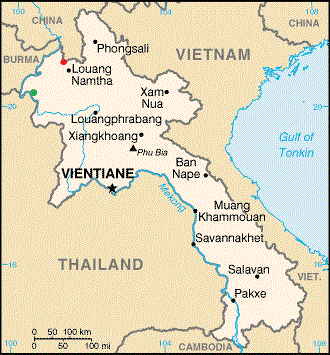There are an estimated 1,600 Asian elephants currently living in Laos. Up to 600 of these are employed in the legal and illegal logging industry. Perhaps another 600 live in the wild while the remainder are employed in the tourism industry. Obviously, elephants require a ridiculous amount of food to survive (300+ kilograms a day of plants and fruit). A domesticated elephant is only viable if it can work to earn it’s keep. Wild elephants are quickly losing their habitat to human expansion, becoming trapped in pockets of wilderness that cannot support their needs. It’s estimated that they will be extinct in the whole of Southeast Asia within the next 50 years.
Life as a logging elephant sounds tough. They are often forced with abusive methods to pull loads beyond their natural ability, which is sometimes enhanced by drugs such as MDMA (ecstasy). They work long hours with inadequate food and medical attention. The working environment is dangerous, often resulting in blindness and other crippling disabilities.
In the last 20 years, a new type of project has developed to attempt to save elephants in the logging industry. As with the eco-tourism discussed in previous posts, they are creating methods where it’s economically viable for locals not to exploit elephants and the natural environment so unsustainably. “Elephant villages” have become homes to many ex-logging elephants and their mahouts (elephant keepers) where they do the relatively easy job of providing rides to tourists a few hours a day in exchange for plenty of food (including delicious bananas), decent medical attention, and a wage for the mahout. Many of the elephants still suffer from their previous abuses, many displaying scars and abscesses from old wounds, and partial and even complete blindness is common.
Of course, even this kind of project is open to greed and exploitation. Some of the villages force the elephants to work longer hours and carry too many tourists at one time. And few earn enough money to provide proper medical attention. There are a lot of choices in Luang Prabang, we attempted to choose the most ethical. The Elephant Village XL was (supposedly) the first of its kind, one of the very few with a full-time vet, and has gained worldwide recognition in reputable publications (Newsweek, the Guardian). The tour operator that arranged our trip (Tiger Trails) also promises to put 10% of its own profits back into the local communities.
The working day of an elephant in the village we visited begins around 7:30 am when they are led down from the jungle to the river to be bathed by tourists (one per elephant). Throughout the day, they are either carrying one or two tourists, plus their mahout, on 40-60 minute rides or standing at their stalls being treated to a constant stream of bananas from delighted tourists. The camp also feeds them fresh sugarcane and bamboo, and they forage in the jungle themselves evenings and mornings. Around 3 pm, they are brought back into the jungle to spend the night. Unfortunately, they cannot roam freely and are kept on a 20 foot chain overnight, apparently because of the dangers of elephant poaching. Their previous training and experience still makes them potentially valuable in the logging industry.
AW + MD

